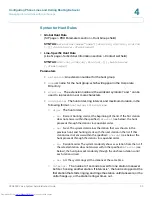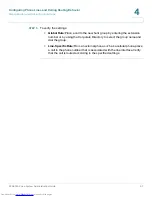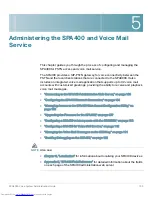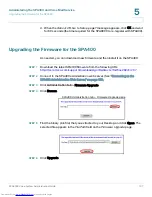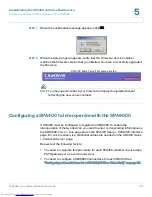
Configuring Phone Lines and Calling Routing Behavior
Managing Inbound Calls with Hunt Groups
SPA9000 Voice System Administration Guide
95
4
•
Using wildcard characters to specify a range of station numbers
Global Rule:
500:name=”TechSupport”,1*,hunt=al
Line-Specific Rule:
1*,hunt=al
In this example, the * symbol is a wildcard character that represents any
number of digits. An incoming call simultaneously rings all stations that begin
with the number 1.
•
Creating multiple hunt groups with the pipe character
Global Rule:
500:name=”TechSupport”,101,102,103,hunt=al|
600:name=”AccountSupport”,2*,hunt=al
Line-Specific Rule:
101,102,103,hunt=al | 2*,hunt=al
Two hunt groups are created. One hunt rule applies to stations 101, 102, and
103. The other hunt rule applies to all stations that begin with the number 2.
•
Ringing stations sequentially with call forwarding to the Auto Attendant
Global Rule:
300:name=”TechSupport”,101,102,100,hunt=re;
20;2,cfwd=aa
Line-Specific Rule:
101,102,100,hunt=re;20;2,cfwd=aa
An incoming call is routed sequentially from the beginning of the list (
hunt=re
).
Every new call is routed to the first station, 101. If the call is unanswered, it
cycles to station 102 and then to station 100. Each phone rings for 20 seconds
(
20
). After 2 cycles, an unanswered call is forwarded to the Auto Attendant
(
cfwd=aa
).
•
Ringing stations randomly with call forwarding to voice mail
Global Rule:
400:name=”Sales”,101,102,103,hunt=ra;30;1,
cfwd=vm2100
Line-Specific Rule:
101,102,103,hunt=ra;30;1,cfwd=vm2100
An incoming call is routed in random order (
hunt=ra
). A new call is routed to a
randomly chosen station. If the call is unanswered, it cycles through the
stations in random order. Each phone rings for 30 seconds (
30
). After 1 cycle is
completed, an unanswered call is forwarded to the voice mail for station 100,
where Line 2 is configured for the voice mail service (
1,cfwd=vm2100
).
Downloaded from
www.Manualslib.com
manuals search engine













